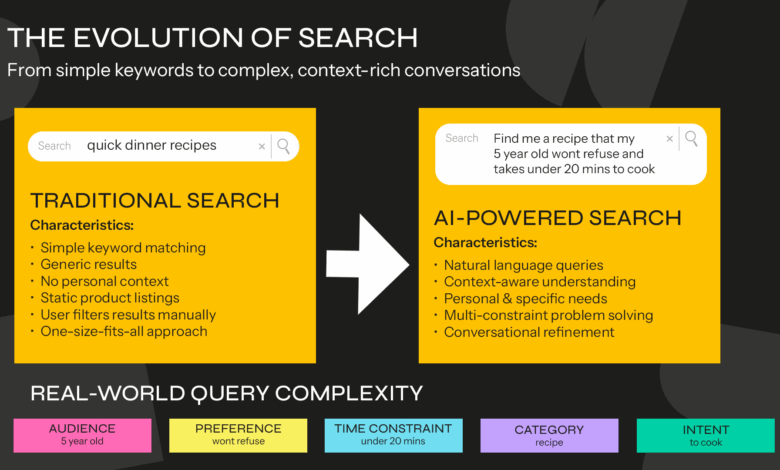
AI, especially Large Language Models (LLMs), is transforming not just how we live and work, but how we shop. Instead of searching ‘quick family dinners’, we now ask highly specific, conversational queries, such as: ‘Find me a recipe that my 5-year-old won’t refuse and takes under 20 minutes to cook’.
This shift away from keyword-based search to dialogue-led discovery marks a turning point for consumers, retailers, and advertisers alike. Context, nuance, and intent now matter more than typing the ‘right’ keyword. ChatGPT has become one of the world’s five most visited websites, overtaking X (formerly Twitter). Meanwhile Google’s search share has dipped below 90% for the first time in decades. Its recent ‘Just Ask Google’ campaign signals an effort to reposition itself for a natural-language future where conversations, not keywords, are the entry point.
For retailers and advertisers, these intent-rich queries are a goldmine. The convergence of retailer data, publisher content, and consumer behaviour could create the richest live dataset in commerce fuelling predictive, adaptive, and hyper-personalised shopping experiences.
For consumers: context-rich, predictive journeys
The benefit for consumers is clear. AI-powered experiences are becoming contextually aware and deeply personalised. Imagine an LLM that knows your favourite clothing brand and automatically suggests alternatives when your size is out of stock, or one that recommends a new vacuum cleaner because it has learned from your address change that you’ve recently moved house.
As LLMs merge with voice assistants and wearable devices, shoppable moments will increasingly emerge as organic byproducts of conversation, much like interacting with a trusted in-store assistant.
For retailers: data as the new leverage
For retailers, data is the new competitive currency. Giants such as Walmart, Kroger, Carrefour, and Tesco already control rich ecosystems of loyalty programs, closed-loop measurement, and logged-in shoppers. These datasets allow them to selectively power LLM interactions while keeping their most valuable data monetised inside their own Retail Media Networks (RMNs).
However, the balance of power is delicate. Even if a retailer withheld product data from an LLM, its unlikely consumers would abandon that store altogether, giving retailers leverage to negotiate terms, much like Amazon’s strategy of limiting external access to its product catalogue.
Smaller retailers have fewer options. Without extensive datasets or brand dominance, they may be forced to share their data to remain visible in AI-powered shopping journeys, sometimes even partnering with dominant platforms simply to stay in the consideration set.
For advertisers: winning over humans and machines
For advertisers, LLM-driven commerce is both a disruption and an opportunity. As the traditional marketing funnel (awareness, consideration, purchase) collapses and is replaced by AI-mediated decision pathways, brands must now compete not only for human attention but also for algorithmic visibility inside the ‘reasoning’ process of LLMs.
This raises urgent new questions:
- What is a brand’s share of voice within LLM outputs?
- How do your campaigns influence AI-generated recommendations?
- How can you measure salience and conversion in a world where bots are gatekeepers?
Those who begin defining these new metrics today will shape the playbook for the next era of advertising.
For publishers: content as fuel
Publishers face continued pressure as AI answers reduce direct traffic and affiliate revenues. But content remains the foundation of LLMs. The opportunity lies in creating AI-native content, structured, metadata-rich, and licensed for model training.
The New York Times’ decision to license its archive to AI companies illustrates how publishers can secure both relevance and revenue in the age of conversational search. Others will need to adapt quickly or risk losing visibility entirely.
RMNs: anchors in the AI era
Retail Media Networks (RMNs) are uniquely positioned to thrive in this landscape. They connect first-party retailer data, media activation, and closed-loop measurement, meaning they can seamlessly integrate with LLM-powered discovery.
As discovery shifts from keyword search to dialogue, retailers that embed their RMNs into LLM systems will gain deeper shopper engagement and stronger influence over the moments that drive purchase decisions.
As AI fast becomes retail’s operating system, and search is becoming conversation, bots are emerging as decision gatekeepers. And the fusion of data, content, and intent will determine which brands, retailers, and publishers thrive, or vanish, in this next era of AI-driven commerce.




